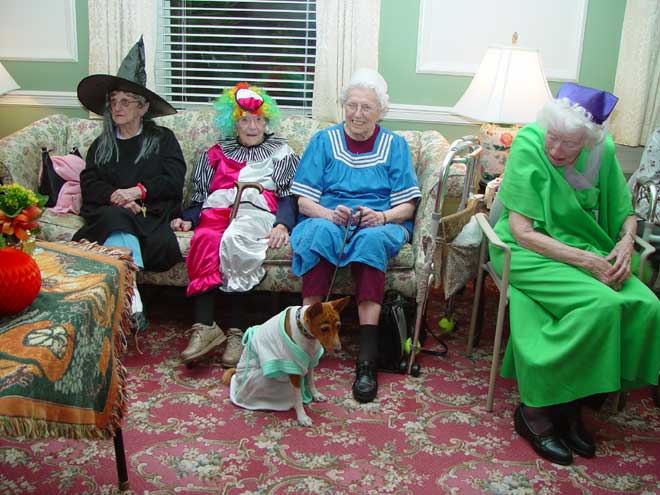|
There is a Yahoo Sighthound Agility Group ~ SHAgility.
Also a Yahoo Group - Basenji Sports
AKC Therapy Dog (THD)/printed with the express consent of Lisa Carroll, at AKC
The purpose of this program is to recognize AKC dogs and their owners who have given their time and helped people by volunteering as a therapy dog and owner team.
The AKC Therapy Dog program awards an official AKC title awarded to dogs who have worked to improve the lives of the people they have visited.
The AKC Therapy Dog title (THD) can be earned by dogs who have been certified by AKC recognized therapy dog organizations and have performed 50 or more community visits.
AKC does not certify therapy dogs; the certification and training is done by qualified therapy dog organizations. The certification organizations are the experts in this area and their efforts should be acknowledged and appreciated.
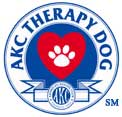
Why Did AKC Start A Therapy Dog Title?
AKC has received frequent, ongoing requests from dog owners who participate in therapy work to "acknowledge the great work our dogs are doing." Many of our constituents are understandably proud of their dogs.
Earning an AKC Therapy Dog title builds on the skills taught in the AKC S.T.A.R. Puppy and Canine Good Citizen programs which creates a sound and friendly temperament needed by a successful therapy dog.
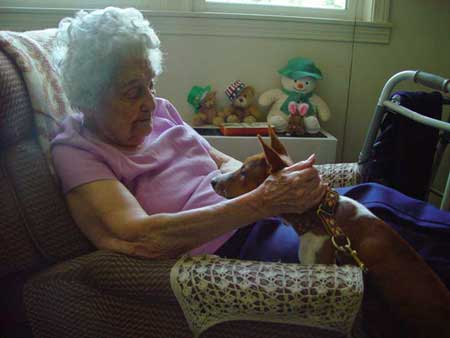
Fern with Henriette at the Hudson Valley Senior Residence
What is a Therapy Dog?
Therapy dogs are dogs who go with their owners to volunteer in settings such as schools, hospitals, and nursing homes.
From working with a child who is learning to read to visiting a senior in assisted living, therapy dogs and their owners work together as a team to improve the lives of other people.
Therapy dogs are not service dogs. Service dogs are dogs who are specially trained to perform specific tasks to help a person who has a disability. An example of a service dog is a dog who guides an owner who is blind, or a dog who assists someone who has a physical disability. Service dogs stay with their person and have special access privileges in public places such as on planes, restaurants, etc. Therapy dogs, the dogs who will be earning the AKC Therapy Dog title, do not have the same special access as service dogs.
It is unethical to attempt to pass off a therapy dog as a service dog for purposes such as flying on a plane or being admitted to a restaurant.
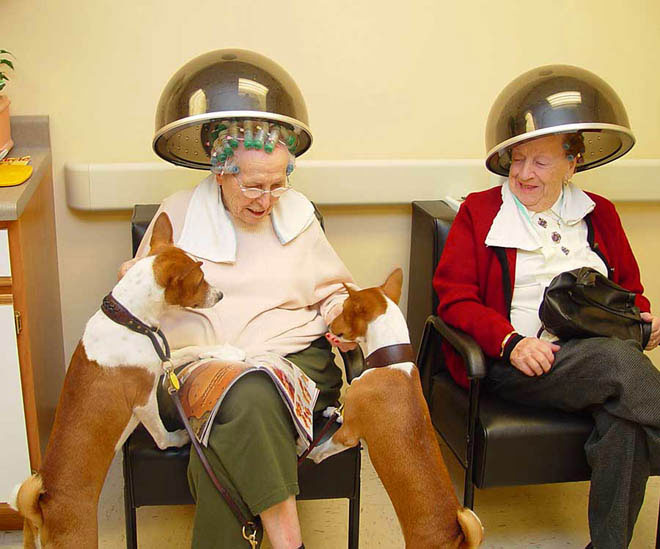
Occhi & Sandy
How to Earn the Title: Qualifications
To earn the AKC Therapy Dog title, you and your dog must meet the following criteria:
Certified/registered by an AKC recognized therapy dog organization.
Perform a minimum of 50 visits.
The dog must be registered or listed with AKC.
All dogs are eligible to earn the AKC Therapy Dog title, including purebreds and mixed breeds. To earn the AKC Therapy Dog title, dogs must be registered or listed with AKC and have a number in order to earn a title. This includes any one of these three options:
AKC registration number – used by purebred dogs.
Enrolled in AKC's PAL Program. (PAL is Purebred Alternative Listing. PAL (formerly called ILP) is a program that allows unregistered dogs of registerable breeds to compete in AKC Performance and Companion Events. PAL dogs include the many wonderful purebred dogs who may have come from shelters or rescue without AKC registration.)
Enrollment in AKC Canine Partners Program – used by mixed breed dogs. (A special Canine Partners enrollment form is available for mixed breed Therapy Dogs — AKC Therapy Dog Enrollment Application. This form must be submitted along with the Therapy Dog title application form.)
How to become a TDI Therapy Dog
Testing Brochure (PDF)
Another CPE game, Snooker.
Here's a Snooker class we ran recently.
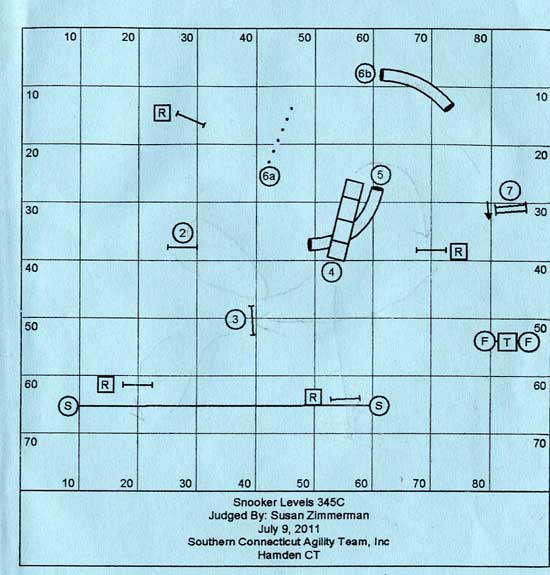
Very fun! Dogs in Level 3, like Fern, need to accumulate 30 points in around 50 seconds.
The game here is that one needs to take one RED jump, followed by a "color," & then a second RED jump, another "color," a third RED jump. another "color."
Now, it's good to plan for the third color to be near obstacle 2, because then you run the course in order. Combos, such as, here, 6a & 6b, have to both be done to accomplish 6.
CPE rules: SNOOKER
Object: To test the planning strategies of the handler and the dog’s ability to concentrate on and execute a handlers’ directions
Scoring and Placements:
To receive a Qualifying Score, the team must have successfully completed 3 “reds” and accumulate a total number of points during the run (see below for list of points). The team MUST have a time to Qualify.
Level 1 26 Points
Level 2 28 Points
Level 3 30 Points
Level 4, 5 & C 32 Points
Timing: SCT’s will be based on 20" dogs; 4”, 8" & 12" receive 5 seconds additional time, there is no additional time allowance for Enthusiast or Specialist, those teams will get a point allowance.
Direction on the course:
Snooker is run as a two-part course. The first part (opening sequence) consists of the handler and dog attempting a “red” jump (1 point each). If the attempt is successful, the team has earned the right to go on to a “color” of choice, 2 through 7. The “color” obstacles are the points designated by the cones assigned to that obstacle on that respective course.
After attempting or completing the color, the procedure repeats itself until the team has completed 3 “reds” and attempted or completed 3 “colors” (3 “reds” MUST be successfully completed for a Qualifying Score).
The following rules must be adhered to in the opening sequence:
� A “red” jump MUST be successfully completed to earn the right to perform a “color” of your choice
� Each “red” jump can only be used once, only 3 can be used during the opening – the 4th is in case one is dropped
� If a “red” jump bar is knocked, a different “red” must be completed before attempting a “color”
� No points will be awarded if a “color” is faulted - the team must continue to another “red” or the closing depending on where they are in the run. 4-paw safety rule is in effect on contacts, zero points if jump bar is dropped (that color is then not available in the closing for points).
� The same obstacle/combo may be used in the opening sequence for each “color”
� If a dog performs a different obstacle than the handler had directed, the team is not penalized if no other faults occur.
� If one of the combo obstacles is faulted, the remainder of the combo must be completed, as a combo is “one obstacle”.
� If the dog “cuts” through the weaves on the way to another obstacle, the dog has then committed to the weaves.
The following rules must be adhered to in the closing sequence:
� Point Accumulation ends if an obstacle is faulted - bar down (from the opening or closing – bars are not reset when a dog is running), or 4-paw safety rule
� Point Accumulation ends if the dog goes Off Course in the closing sequence (includes “cutting” through the weaves)
� SCT ends, timekeeper will blow their whistle - time only stops when the dog touches the table with at least one paw Point Accumulation will end if any of the following occurs:
� If a “red” is faulted, then a “color” is taken
� If a “red” is completed, then two “colors” are taken
� If a “red” then a “color” is taken, then the same “red” is taken
� If two “reds” in a row are taken, same or different, bar up or down
� If a “color” is taken before a “red”
� 4th “red” is taken, after 3 others were successfully completed
� The handler purposely uses the table to move around the course
� When time expires If the Judge says “Thank you” (or signals with a whistle) at any point, or the timer indicates “play time” has expired, the team MUST move immediately to the table to stop the clock. The dog must have completed their last obstacle past the point of faulting to earn points. Any delay in heading for the table, OR directing the dog to perform an obstacle on the way to the table will result in the loss of the last point value earned. There is no penalty if the dog takes an obstacle on the way to the table without handler direction.
The Judge’s decision is final.
<previous page> <next page>
|
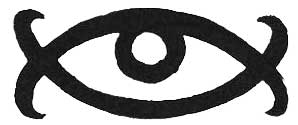 Training Conversation
Training Conversation